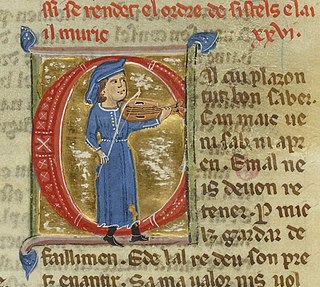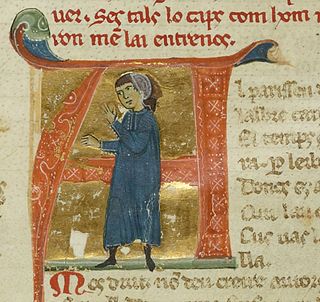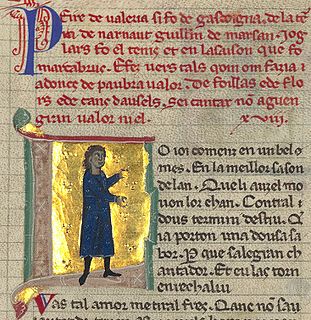
A troubadour was a composer and performer of Old Occitan lyric poetry during the High Middle Ages (1100–1350). Since the word troubadour is etymologically masculine, a female troubadour is usually called a trobairitz.

Jaufre Rudel was the Prince of Blaye and a troubadour of the early–mid 12th century, who probably died during the Second Crusade, in or after 1147. He is noted for developing the theme of "love from afar" in his songs.
Occitan literature is a body of texts written in Occitan, mostly in the south of France. It was the first literature in a Romance language and inspired the rise of vernacular literature throughout medieval Europe. Occitan literature's Golden Age was in the 12th century, when a rich and complex body of lyrical poetry was produced by troubadours writing in Old Occitan, which still survives to this day. Although Catalan is considered by some a variety of Occitan, this article will not deal with Catalan literature, which started diverging from its Southern French counterpart in the late 13th century.
Grimoald, Grimald, Grimoart, Grimwald, Grimuald, or Grimbald is a Germanic personal name.

Peire Cardenal was a troubadour known for his satirical sirventes and his dislike of the clergy. Ninety-six pieces of his remain, a number rarely matched by other poets of the age.

Peire Vidal was an Old Occitan troubadour. Forty-five of his songs are extant. The twelve that still have melodies bear testament to the deserved nature of his musical reputation.
The sirventes or serventes, sometimes translated as "service song", was a genre of Old Occitan lyric poetry practiced by the troubadours.

Peire Rogier was a twelfth-century Auvergnat troubadour and cathedral canon from Clermont. He left his cathedral to become a travelling minstrel before settling down for a time in Narbonne at the court of the Viscountess Ermengard. His life and career are known because his late thirteenth-century vida survives, as well as some of his works. The reliability of his vida, upon which all the details of his goings and comings are known, however, is not complete. According to it, he left the religious life to become a jongleur.
Marcoat was a minor Gascon troubadour and joglar who flourished in the mid twelfth century. He is often cited in connexion with Eleanor of Aquitaine and is placed in a hypothetical "school" of poetry which includes Bernart de Ventadorn, Marcabru, Cercamon, Jaufre Rudel, Peire Rogier, and Peire de Valeria among others. Of all his works, only two sirventes survive: Mentre m'obri eis huisel and Una re.us dirai, en Serra.

Peire d'Alvernhe or d'Alvernha was an Auvergnat troubadour with twenty-one or twenty-four surviving works. He composed in an "esoteric" and "formally complex" style known as the trobar clus. He stands out as the earliest troubadour mentioned by name in Dante's Divine Comedy.

Peire de Valeira, Valeria, or Valera was a Gascon troubadour. Since troubadour poetry probably originated in northwest Aquitaine and first spread—within a generation—south into Gascony, Peire was one of the earliest troubadours. Only two of his poems survive, one canso and one cobla.

Peire Raimon de Tolosa was a troubadour from the merchant class of Toulouse. He is variously referred to as lo Viellz and lo Gros, though these are thought by some to refer to two different persons. On the other hand, lo Viellz could refer to his being of an early generation of troubadours. Eighteen of Peire Ramon's poems survive, one canso with a melody.
Guilhem Peire Cazals de Caortz or Guilhem Peire de Cazals was a troubadour of the first half of the thirteenth century. He was born or lived in Cahors, Quercy, from which his name "de Caortz". Eleven of his works, including one tenso, survive.

Bernart de Venzac was an obscure troubadour from Venzac near Rodez in the Rouergue. He wrote in the Marcabrunian style, leaving behind five moralising pieces and one religious alba. Two of his works were confused by copyists with those of Marcabru in some manuscripts.

Peire Bremon lo Tort was a troubadour from the Viennois. Though only two of his pieces survive, his poetry is characterised by Francoprovençalisms. According to his short vida, he was "honoured by all the notable men."
A gab or gap is a troubadour boasting song. It is often considered related to the tenso and partimen, two types of debate poem. Sometimes the gab is not considered a separate genre of poetry but simply a boast found within another genre, commonly the sirventes.
Peire de Corbiac or Corbian was a Gascon cleric and troubadour of the thirteenth century. His most famous works are a religious piece, the Prière à la Vierge, and his "treasures", Lo tezaurs.
Gonzalo Ruiz or Rodríguez was the feudal lord of La Bureba throughout much of the mid-twelfth century. He held important positions at the courts of successive Castilian monarchs and guarded the frontier with Navarre, to whose Jiménez rulers he was related. He was a cultured man, with connexions to at least one, possibly two, troubadours. He may have written poetry himself, though in what language is not known.
Duran Sartor de Paernas or Duran Sartre de Carpentras was a Provençal troubadour from Pernes near Carpentras. The nickname sartor means "tailor". Two sirventes have been attributed to him, both reflect opposition to the royal crusade in Occitania: "Vil sirventes leugier e venassal" was written towards 1210, certainly before 1220, and "En talent ai qu'un sirventes encoc," which was written in 1242, during the Saintonge War. Although Duran criticises the crusade against alleged heretics, he encourages further efforts at crusading against Muslims.